Sri Lankan Replacement *-Notes: 1970 - 2018
By Dr Kavan Ratnatunga
(IBNS:12165-R)
- 1970-10-26 Replacement V & W prefix *-Notes for Rs50 and Rs100
- 1987-1990 Replacement R prefix *-Notes
- 1991-1994 Replacement Z prefix *-Notes
- 1995-2006 Replacement Z prefix *-Notes
- 2009-05-20 Replacement X prefix *-Note
- 2010-2018 Replacement Z prefix *-Notes
According to the International Bank Note Society (IBNS),
Replacement notes are banknotes that are inserted into bundles of
notes to replace banknotes damaged during production, ensuring the
first and last serial numbers in a bundle of banknotes indicate the
number of banknotes in the bundle. Replacement Notes are usually
identified by special serial numbers.
1
Since
Replacement banknotes were introduced in 1910 in the USA and
identified with a * at the end of the serial number, these notes are
called *-Notes.
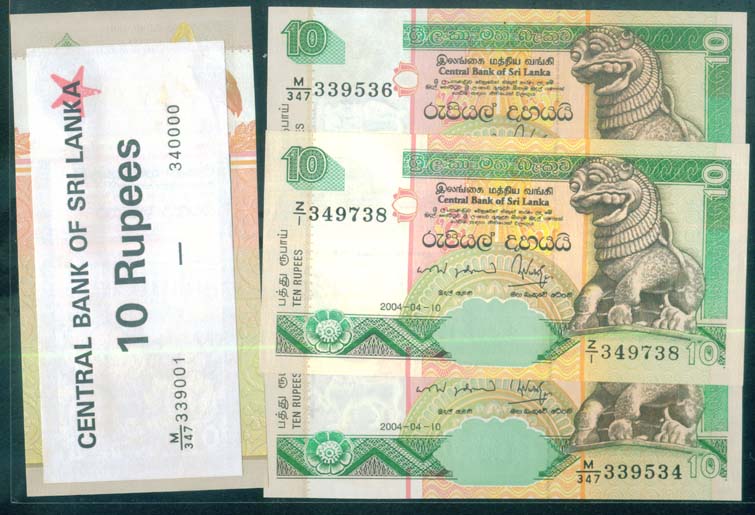 Since it is not practical to print a replacement banknote with the
same serial number as the damaged note, set of replacement notes with
a different prefix is printed to replace the small fraction of notes
detected to be damaged in the quality control subsequent to printing
Serial Number. Statistically, this is about 2 or 3 notes per 1000
notes printed. In Sri Lanka till 2017, Mint bundles of 1000 notes, as
10 packs of 100, are issued by the Central Bank and have a slip packed
on the top of the Brick with the denomination. In example shown prefix
and first 339001 and last 340000 serial number in the bundle. If any
bundle of 1000 have any replacements included, a Star is Rubber
Stamped on the Slip. One or more Replacement notes would then be found
within the sequence, sometimes even a full pack of 100 notes.
Since it is not practical to print a replacement banknote with the
same serial number as the damaged note, set of replacement notes with
a different prefix is printed to replace the small fraction of notes
detected to be damaged in the quality control subsequent to printing
Serial Number. Statistically, this is about 2 or 3 notes per 1000
notes printed. In Sri Lanka till 2017, Mint bundles of 1000 notes, as
10 packs of 100, are issued by the Central Bank and have a slip packed
on the top of the Brick with the denomination. In example shown prefix
and first 339001 and last 340000 serial number in the bundle. If any
bundle of 1000 have any replacements included, a Star is Rubber
Stamped on the Slip. One or more Replacement notes would then be found
within the sequence, sometimes even a full pack of 100 notes.
The Central Bank did not inform the Public about Replacement notes
which went unnoticed by collectors. Around 1999 their identity was
told to collector Johann Dekker by former Superintendent of Currency
Ms Chitra Ariyaratne when he had asked her about notes with a different
prefix.
2
Around 2004 I returned from the USA to reside in Sri Lanka, I can
remember finding Z notes in circulation and even getting some
Uncirculated Replacement Banknotes from an ATM. Now with more
awareness of the premium paid for them by collectors, uncirculated
replacement notes were later mostly available only through dealers,
who have established contacts with bank employees. About two replacement
notes maybe found by searching through a bundle of 1000 circulated notes.
With No printing of Z notes since the 2017-05-22 date, Z notes are now
rarely seen in circulation.
Rarity is a driving force in collecting currency Notes. A Replacement
note that is more than 300 times more rare than a regular note is
much sort after and collectible. Sadly they have hardly been properly
documented.
In 2018 I submitted a Right To Information (RTI) to CBSL to get the
range of Replacement Serial numbers used for each denomination and
date on note. That gives an upper limit to what was issued as some may
remain after the print run. CBSL provided information since 2010
3,
but has claimed information about older issues is
unavailable at CBSL or DeLaRue.
4,
5
This is surprising, as all prefixes and Serials used should be part of
the documentation of each currency note printing, and sent with every
shipment.
I suspect the relevant files are in some external archive which may be
costly in accessing and therefore CBSL is not interested to find this
information.
Since inception in 1950, BankNotes by the Central Bank of Ceylon had
been printed by Bradbury Wilkinson & Company Limited.
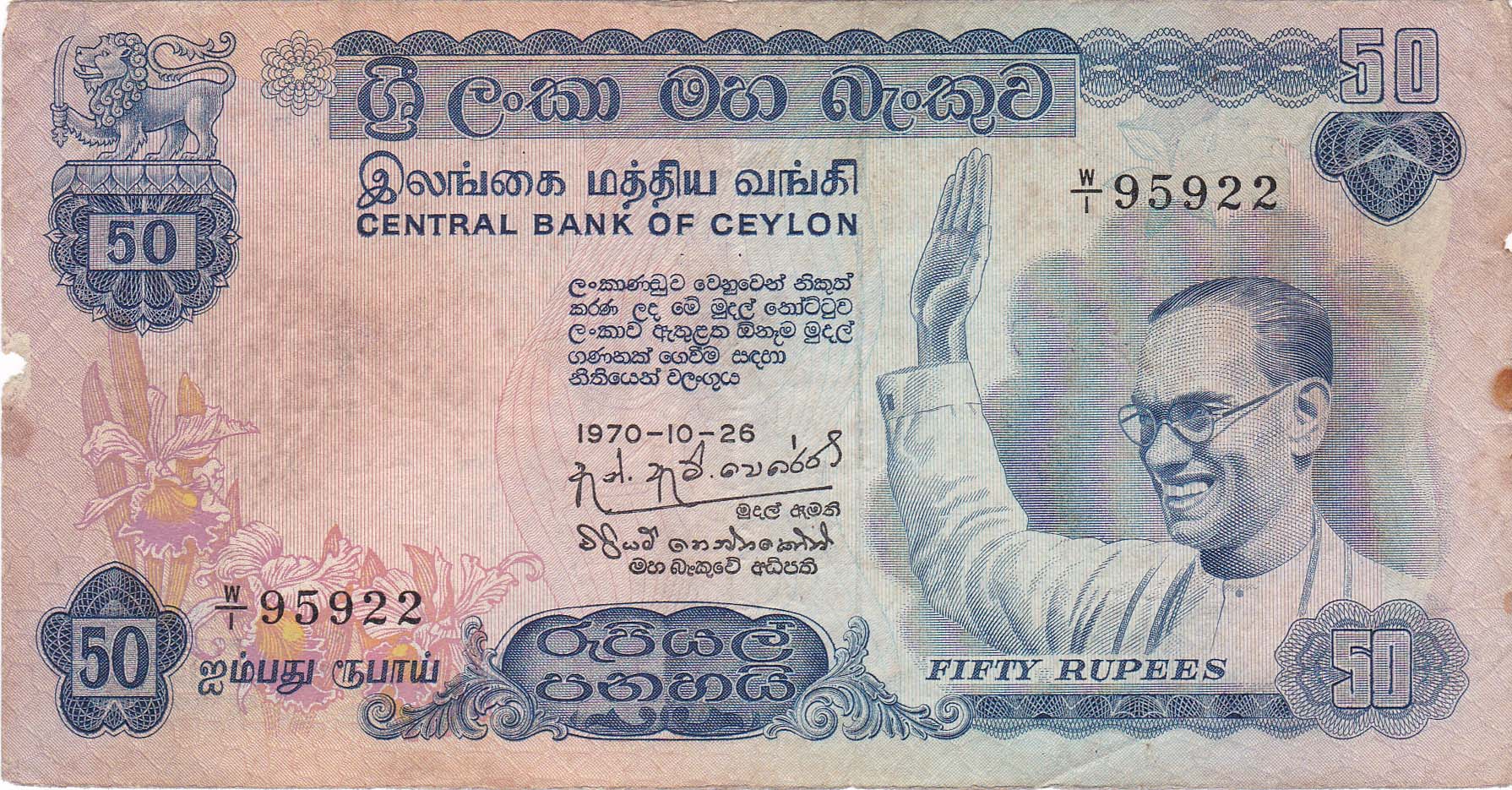 It was printer Thomas De La Rue who introduced Replacement BankNotes
in Sri Lanka with the issue of the high-value currency
notes
with the Portrait of Late Prime Minister S. W. R. D. Bandaranaike with
right hand raised.
This emergency printing of 9 Million Rs50 and 6 Million Rs100 with two
dates 1970-10-26 and 1970-12-9 was given to a different UK printer to
keep an eminent Demonetization Confidential.
The SLFP led by Mrs Sirimavo Bandaranaike was returned to power at
Election held on 1970 May 29th. The Prevention of the Avoidance of
Income Tax Act was passed and in terms of this Act the Government on
1970 October 26th, demonetized all currency notes of the denominations
of Rupees 50 and 100 bearing a date prior to that of the demonetization.
It was printer Thomas De La Rue who introduced Replacement BankNotes
in Sri Lanka with the issue of the high-value currency
notes
with the Portrait of Late Prime Minister S. W. R. D. Bandaranaike with
right hand raised.
This emergency printing of 9 Million Rs50 and 6 Million Rs100 with two
dates 1970-10-26 and 1970-12-9 was given to a different UK printer to
keep an eminent Demonetization Confidential.
The SLFP led by Mrs Sirimavo Bandaranaike was returned to power at
Election held on 1970 May 29th. The Prevention of the Avoidance of
Income Tax Act was passed and in terms of this Act the Government on
1970 October 26th, demonetized all currency notes of the denominations
of Rupees 50 and 100 bearing a date prior to that of the demonetization.
Replacement *-Notes for Rs50 and Rs100
were issued with Prefix W/1 and V/1 rather than
the D/ and E/ on the regular note. Assuming a damage
rate which is similar to current production, one would expect less
than about 18,000 notes for the 6 million Rs50 notes dated
1970-10-26. However, the Serial number on Replacement W/1 note
in the Lakdiva collection is 95922. Others reported are randomly distributed.
Probably 100,000 notes were printed in an attempt to replace notes
with the same serial number as was damaged and removed. Dealer
Selliah Jackson informs me that although he has seen a number of these
notes in both denominations, all of them are of the First date.
6
As this is statistically very unlikely, it could indicate that they
used the prior replacements from the first date, when replacements
were needed at quality control of the second date.
After this issue, the printing of Sri Lanka banknotes reverted to
Bradbury Wilkinson and there were No replacement notes used from 1971
to 1986. Not sure what method Bradbury Wilkinson used, but based on
comments by Late Tuan Sallay as I remember, I suspect they supplied
printed notes with the damaged Serial Number. In 1984 Bradbury
Wilkinson set up a plant in Biyagama, Sri Lanka. In 1986
Bradbury Wilkinson was acquired by Thomas De La Rue Company Limited.
In 1986, the English name became Central Bank of Sri Lanka, but
Bradbury Wilkinson name continued on the series of Currency Notes
issued from 1987 till 1990. However, the principal owners DeLaRue
introduced Replacement Notes.
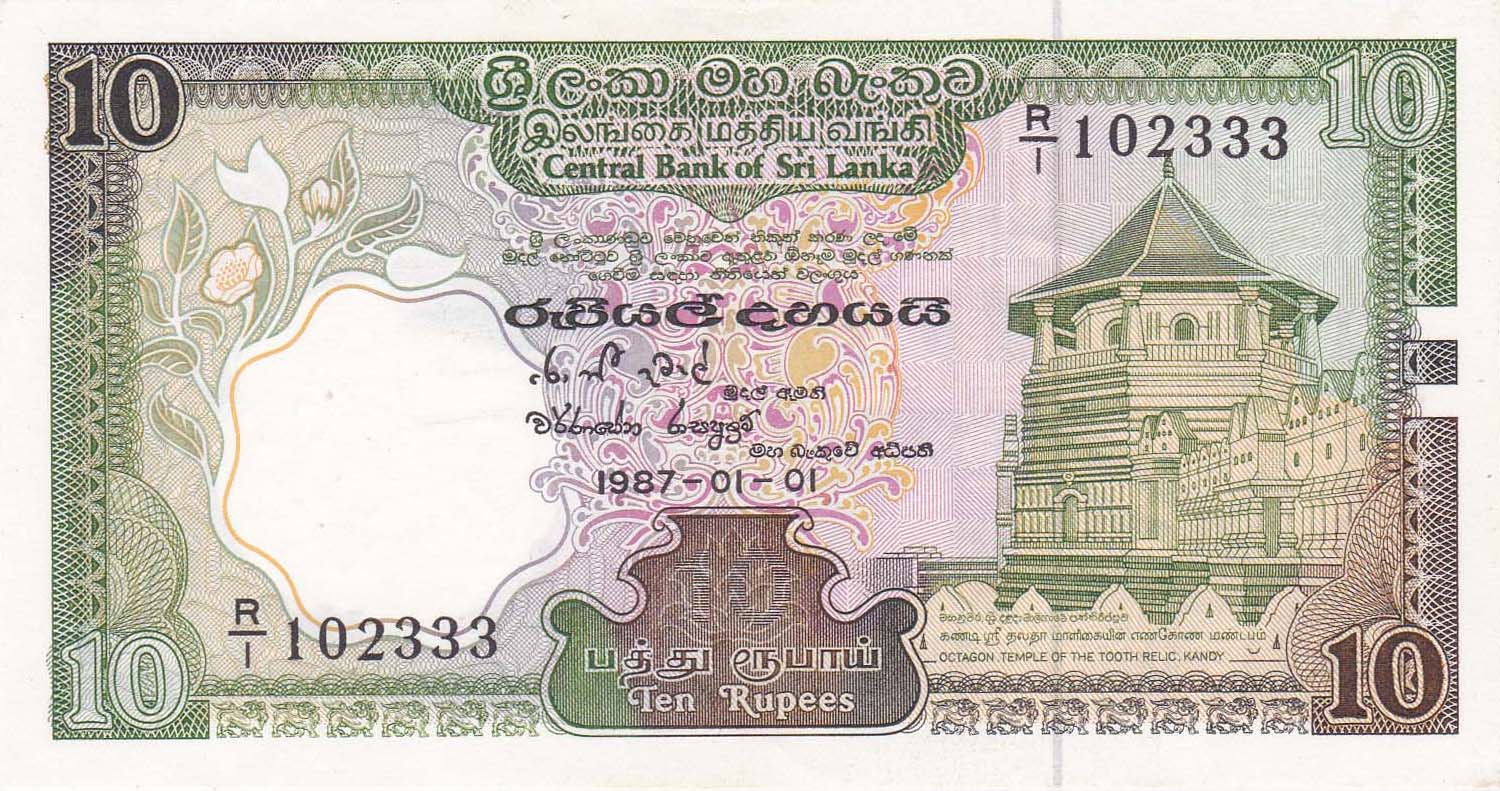 I have an example of R/1 dated 1987-01-01,
used for the Rs10 note.
I have images for
R/3 for the Rs20 note,
R/4 for the Rs50 note,
R/5 for the Rs100 note,
R/7 for the Rs500 note,
and R/8 for Rs1000 note.
CBSL has claimed they have no documentation from that Era. It was
only after practically all of these notes had gone out of circulation,
was there collector awareness in replacement notes.
I have an example of R/1 dated 1987-01-01,
used for the Rs10 note.
I have images for
R/3 for the Rs20 note,
R/4 for the Rs50 note,
R/5 for the Rs100 note,
R/7 for the Rs500 note,
and R/8 for Rs1000 note.
CBSL has claimed they have no documentation from that Era. It was
only after practically all of these notes had gone out of circulation,
was there collector awareness in replacement notes.
Low serial numbers 2891 and 366, for the 1988 Rs500 and 1989 Rs1000
replacements are known. The expected 0.2% of 1987 replacement notes is
10,000 and 20,000 for a 5M and 10M issue. Also the higher denomination
replacements of these older issues are relatively more common than the
lower. So most probabaly the 1987 Rs 500 and Rs 1000 did not use
replacements.
Considering signatures, dates and varieties in Sri Lanka currency
issued between 1987 and 1990 there are 22 possible and 20 likely
replacement notes Denomination, Dates and varieties of which 15
have been reported to me with images.
The missing 5 are all the lower denomination Rs10, Rs20, Rs 50, Rs100.
However, replacement *-Notes of
all Denominations and all dates of the Series 9 are known.
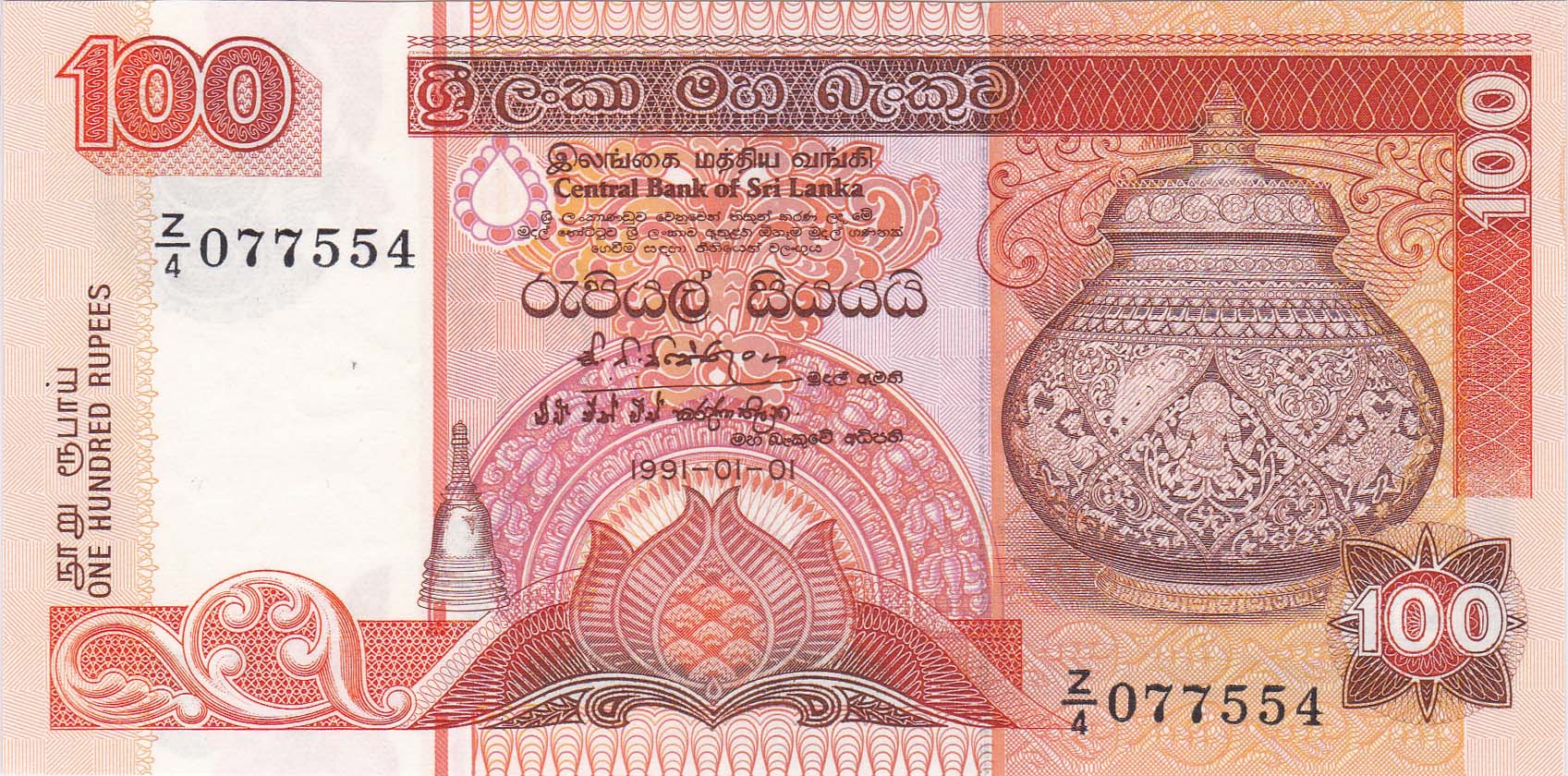 In 1991 CBSL issued a new Series of Currency Notes. Printers name
changed to Thomas De La Rue Company Limited and the replacement prefix
from R/ to Z/.
Replacement notes with prefix
Z/1 for the Rs10 notes,
Z/2 for the Rs20 notes,
Z/3 for the Rs50 notes,
Z/4 for the Rs100 notes,
Z/5 for the Rs500 notes,
and Z/6 for the Rs1000 notes
were issued. Like the prefix number, the serial number increased as
dates and new signature pairs were issued until 2006.
Low denominations Rs10, Rs20 and Rs50 replacement notes are rare to
find till 1995. Of the 9 possible replacement notes, only 4 (3 with
images) have been reported to me, as they too had gone out of
circulation by 2000. Because higher denominations circulate longer of
8 possible replacement Rs100, Rs500 and Rs1000 notes before 1995, all
have been reported to me with images and I have examples of 5 of them.
Z/7 was used for the new Rs2000
notes issued for the
first time in 2005 November.
Replacement *-Notes
of all Denominations and dates of Series 10 are known.
In 1991 CBSL issued a new Series of Currency Notes. Printers name
changed to Thomas De La Rue Company Limited and the replacement prefix
from R/ to Z/.
Replacement notes with prefix
Z/1 for the Rs10 notes,
Z/2 for the Rs20 notes,
Z/3 for the Rs50 notes,
Z/4 for the Rs100 notes,
Z/5 for the Rs500 notes,
and Z/6 for the Rs1000 notes
were issued. Like the prefix number, the serial number increased as
dates and new signature pairs were issued until 2006.
Low denominations Rs10, Rs20 and Rs50 replacement notes are rare to
find till 1995. Of the 9 possible replacement notes, only 4 (3 with
images) have been reported to me, as they too had gone out of
circulation by 2000. Because higher denominations circulate longer of
8 possible replacement Rs100, Rs500 and Rs1000 notes before 1995, all
have been reported to me with images and I have examples of 5 of them.
Z/7 was used for the new Rs2000
notes issued for the
first time in 2005 November.
Replacement *-Notes
of all Denominations and dates of Series 10 are known.
No Replacements were issued with the Polymer Rs200
notes
issued for the 50th Anniversary of Independence in 1998. Packs of
notes had missing serial numbers. and although only just over 20.5
million notes were printed the prefix extended at least to N/22 559...
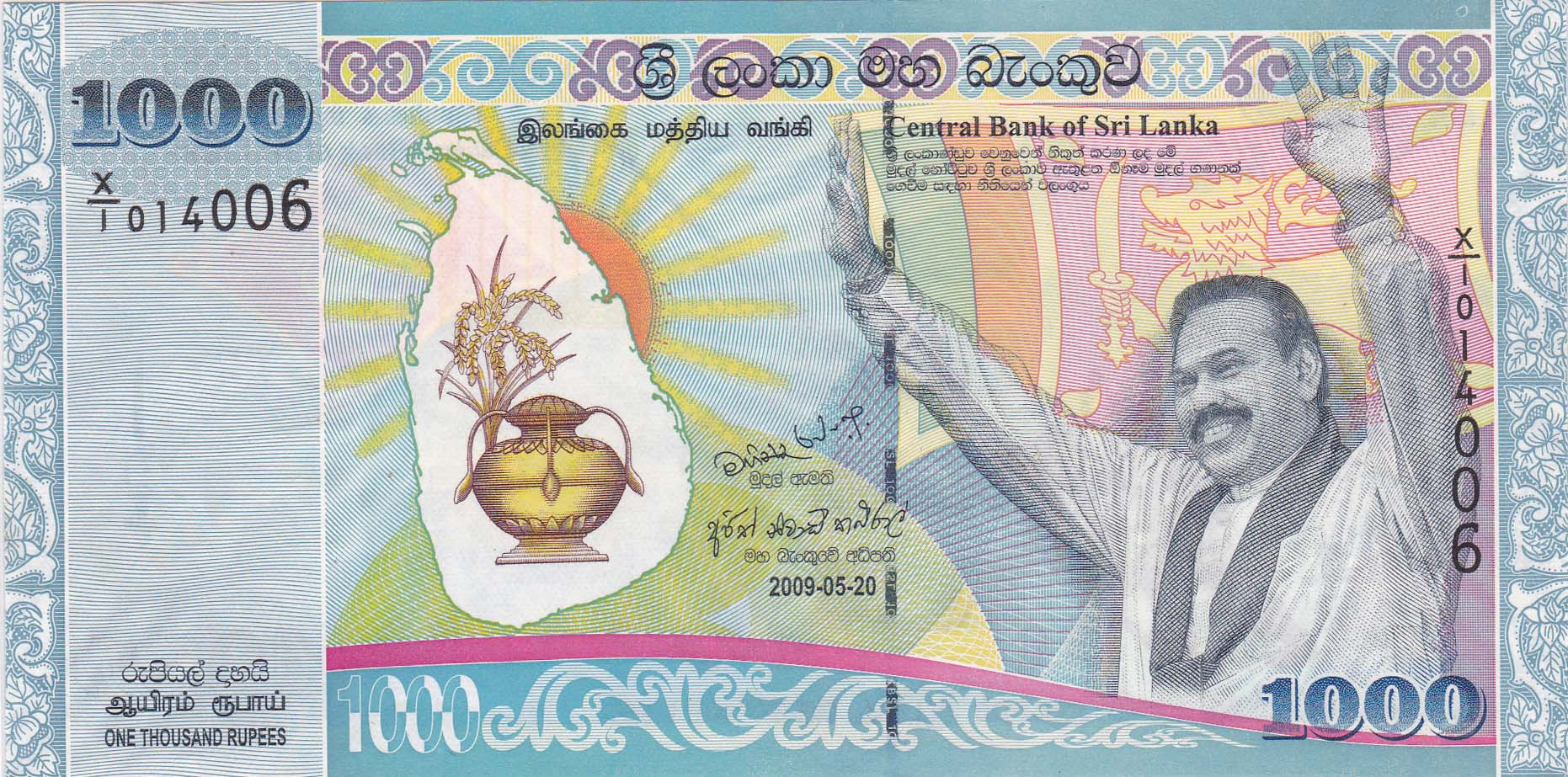 The Rs1000 note
with Mahinda Rajapaksa, issued to commemorate the end of the civil war
in 2009 used X/1 as the Replacement Prefix instead of Q/
on the regular note.
The Rs1000 note
with Mahinda Rajapaksa, issued to commemorate the end of the civil war
in 2009 used X/1 as the Replacement Prefix instead of Q/
on the regular note.
The next and current series of notes were issued first dated
2010-01-01, and the serial number restarted from 000001. The same
serial prefix was used as in 1991 omitting Z/1 as Rs10 was now a coin
and Z/7 as Rs2000 was discontinued.
Replacement prefixes
Z/2 for the Rs20 notes,
Z/3 for the Rs50 notes,
Z/4 for the Rs100 notes,
Z/5 for the Rs500 notes,
Z/6 for the Rs1000 for notes,
and Z/8 for the new Rs5000 notes,
were used.
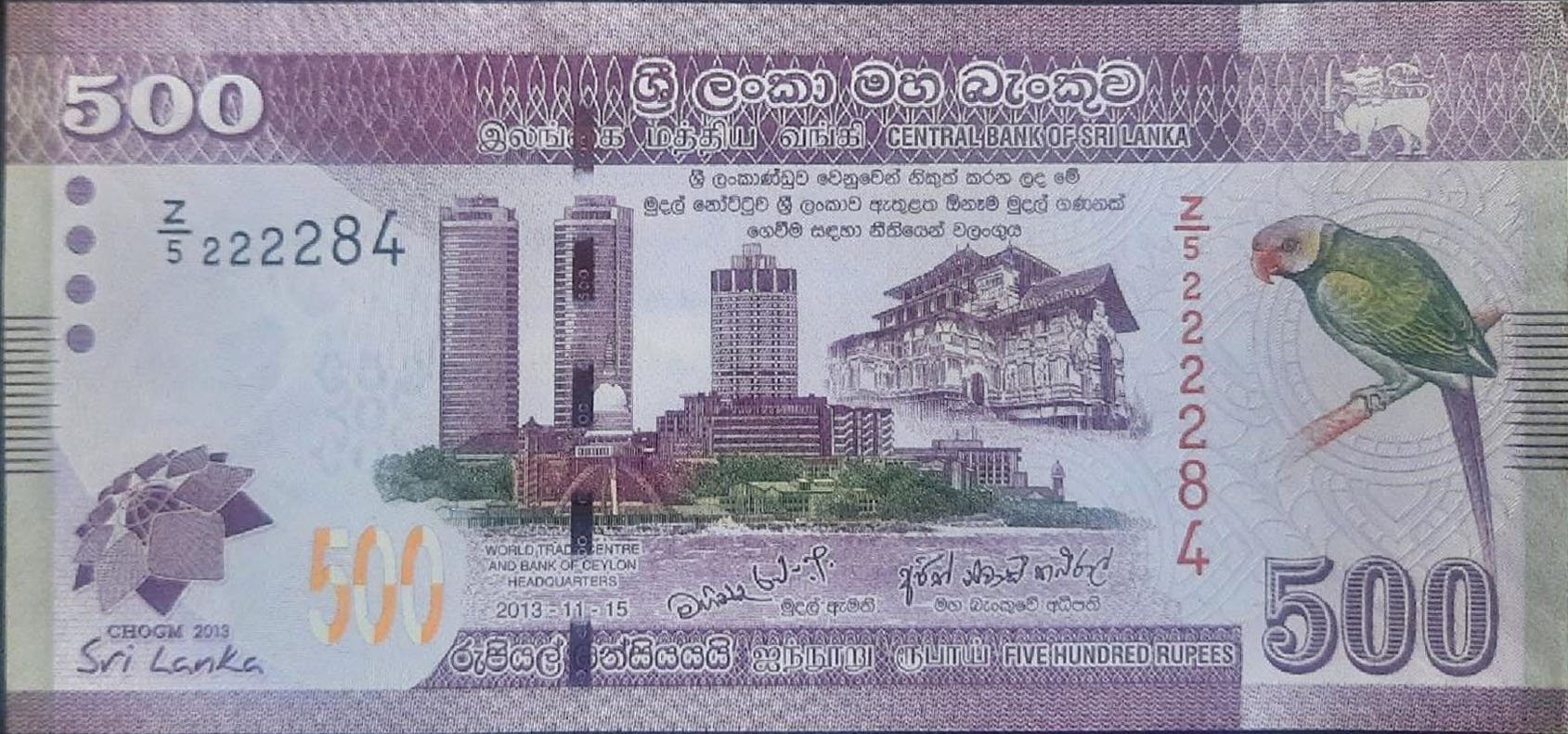 In 2013 a slightly modified Rs500
note was
issued to commemorate CHOGM but these range of notes used the same
prefix series for both the currency and the replacements.
The next date was 2015-02-04 saw a continuation of serial numbers.
In 2013 a slightly modified Rs500
note was
issued to commemorate CHOGM but these range of notes used the same
prefix series for both the currency and the replacements.
The next date was 2015-02-04 saw a continuation of serial numbers.
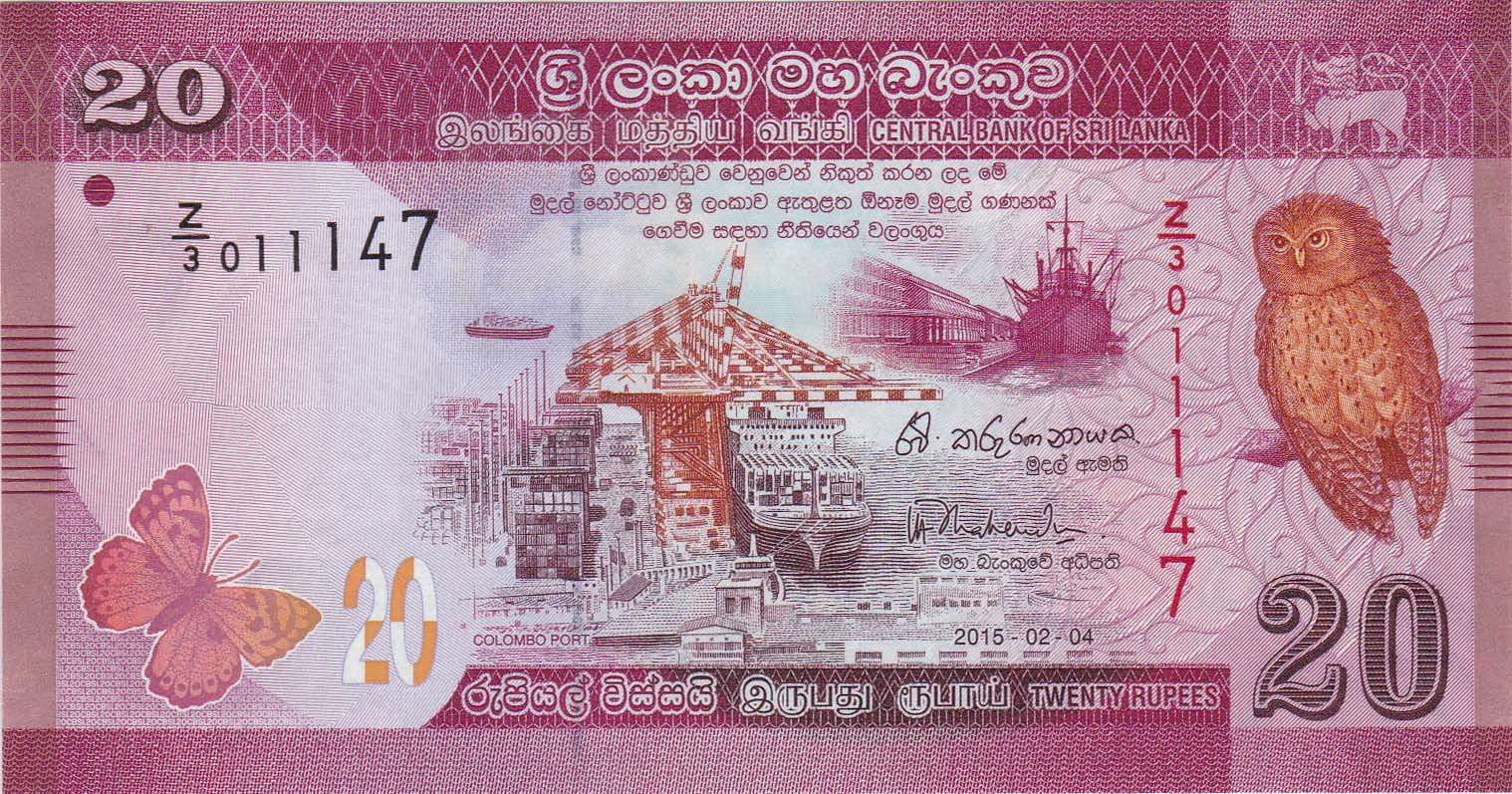 In 2017 November collector Ravi Ratnapala purchased on eBay the 2015
Rs20 replacement currency note with Z/3 found in a bundle of
notes with prefix W/312.
7
This was a total surprise as since
1991 Z/2 was always used for the Rs20 and Z/3
exclusively for Rs50. By then we had already seen 2015 Notes with
Z/10 for the Rs20,
Z/30 for the Rs100,
Z/50 for the Rs1000, and
Z/60 for the Rs5000, being used.
So it was clear that the Rs20 Z/3 was a short-lived deviant.
Our guess was that Z/2 had reached the Million mark and TDLR
had next used Z/3 initially.
An RTI request to CBSL answered that 11,800 Rs20 Z/3 notes had
been printed and used between Rs20 prefixes W/311 and W/314. The
bigger surprise was that only 786,000 had been used for Z/2.
3
When I questioned the logical reason for the Rs20 Z/3,
CBSL's only reply was I quote
The selection of the replacement prefix and the serial numbers are
purely business decisions mutually agreed by the CBSL and the printer.
4
In 2017 November collector Ravi Ratnapala purchased on eBay the 2015
Rs20 replacement currency note with Z/3 found in a bundle of
notes with prefix W/312.
7
This was a total surprise as since
1991 Z/2 was always used for the Rs20 and Z/3
exclusively for Rs50. By then we had already seen 2015 Notes with
Z/10 for the Rs20,
Z/30 for the Rs100,
Z/50 for the Rs1000, and
Z/60 for the Rs5000, being used.
So it was clear that the Rs20 Z/3 was a short-lived deviant.
Our guess was that Z/2 had reached the Million mark and TDLR
had next used Z/3 initially.
An RTI request to CBSL answered that 11,800 Rs20 Z/3 notes had
been printed and used between Rs20 prefixes W/311 and W/314. The
bigger surprise was that only 786,000 had been used for Z/2.
3
When I questioned the logical reason for the Rs20 Z/3,
CBSL's only reply was I quote
The selection of the replacement prefix and the serial numbers are
purely business decisions mutually agreed by the CBSL and the printer.
4
The Rs20 Z/3 replacement note created a big frenzy among
Banknote collectors in Sri Lanka.
One collector told me he paid a ridiculous Rs60,000(US$350) for
an uncirculated pair.
It takes about half an hour to check a 1000 bundle at about 2 seconds
per note. I gave up after searching 2000 notes, as they were hard to
get from the Bank and statistically I would need to search over 20,000
notes to find one.
Collector Harry Gunawardena patiently searched through 10,000
circulated Rs20 notes and found one Z/3
8,
another claimed to have searched 50,000 notes and not found one.
About a year later an uncirculated bundle of Rs20 Z/3 notes
appeared in the numismatic market and finally sold for Rs9,000(US$50) a pair.
The Replacement prefix has 11 varieties for 6 denomination notes of
the 2015-02-04 date. All replacement *-Notes
of Series 11 are known and document with range of prefix.
Then sometime in 2017, after all this drama, DeLaRue introduced a
Single Note Inspection Machine (SNIM), for quality control. They kept
a digital record of the accepted serial numbers and did away with
Replacement Notes. So replacement notes will not be printed again.
Bundles of notes will not be labeled with the first and last Serial
numbers. With the possibility of missing numbers in between, the brick
will just have 1000 notes. The first note to be issued this way was
the Rs100 note dated 2016-07-02. With no Serial number on the packs,
they were issued from CBSL in random order. Much larger prefixes were
seen in circulation months before the beginning of the series. The
other five denominations of the 2016-07-02 date has replacement notes.
None of the regular currency notes dated 2017-05-22 and after has
Replacement notes.
CBSL made an announcement
to Local Commercial banks on 2018 June 22nd.
8
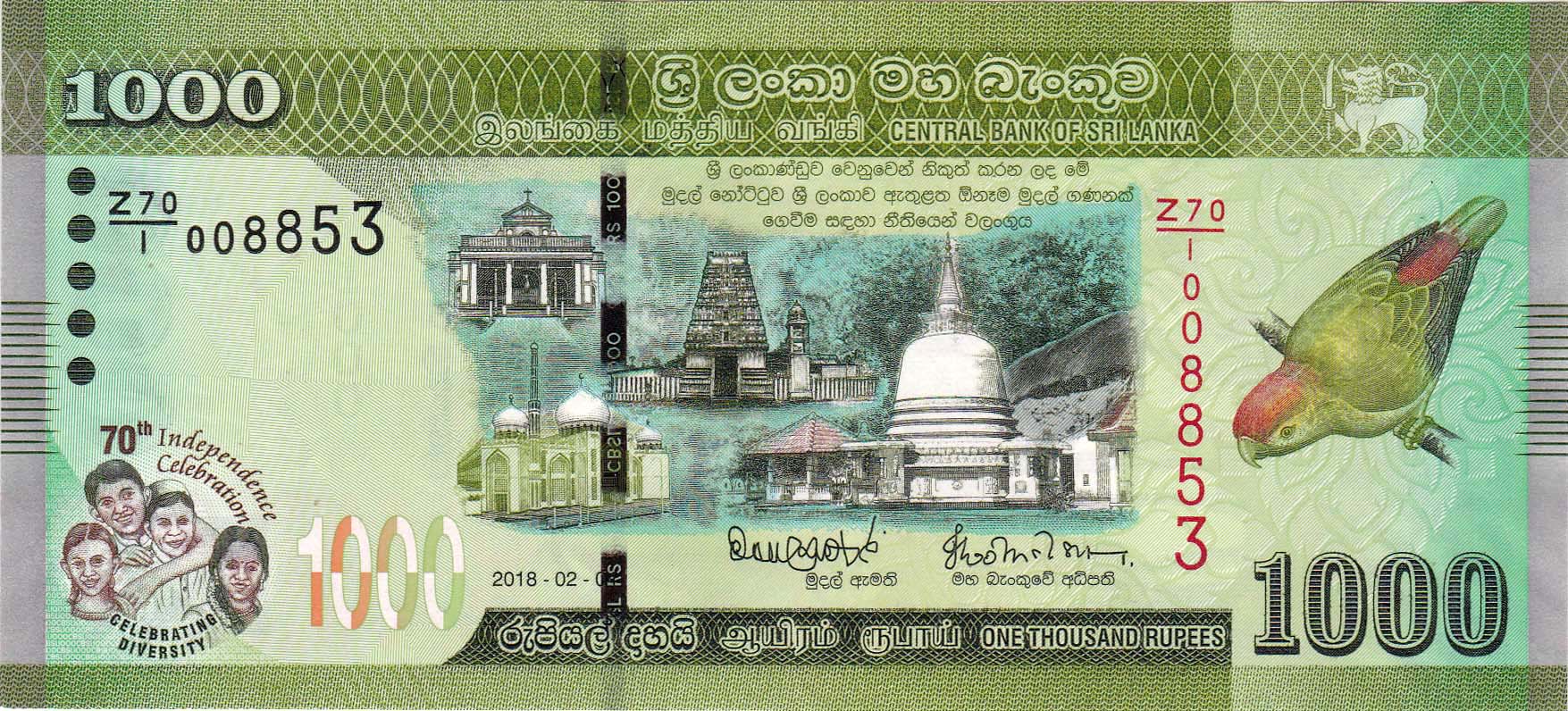 The last date on a Sri Lanka replacement note is 2018-02-04 which was
the 70th Anniversary of Independence commemoration Rs1000
note where
the S70/ special prefix in the regular note was replaced
with Z70/1 prefix.
The last date on a Sri Lanka replacement note is 2018-02-04 which was
the 70th Anniversary of Independence commemoration Rs1000
note where
the S70/ special prefix in the regular note was replaced
with Z70/1 prefix.
Reliable Information on Replacement Sri Lanka Notes had not been
comprehensively published.
Misinformation has been published even in the Krause Standard Catalog
of World Paper Money (SCWPM). Particularly about the 1979 Rs100
for which Z/ was the regular prefix letter.
Consequently, for example, there are many PMG certified
note and
note which reflect this error.
Heritage Auctions corrected their listings when I informed them of error.
10
Total of 105 possible Sri Lanka Replacement BankNotes of different,
Denomination, Date, Prefix and Variety are listed in
Catalog.
Examples of 13 of them not seen or reported to me so far.
Logically at least 9 were most probably were issued, but remain unconfirmed.
Of the remaining 92, the LakdivaNote collection has 68 Replacement BankNotes
which includs 61 from 1995 and after that is complete except the CHOGM Rs500.
A Typeset replacements ignoring Date-signatures and minor Variety, but
including prefix, has 37 Notes of which 36 have been illustrated. The
LakdivaNote collection has 28 of the 37 Types of replacement notes..
2 or 3 notes per 1000 that passed through your hands before 2018 was
probably a replacement and even in circulated condition worth a small
premium over face value. Each Banknote was like a free lottery Ticket,
which does not cost anything to check. 1000 note pack took 30 minutes.
I thank Selliah Jackson, Dushantha Lakmal, Johanne Dekker, Ravi
Ratnapala, Preethi Jayawardena, Mohamed Ishfar, Chanaka Sampath,
K.W.M. Samarasinghe for confirming with images, the more rare older
dates and denominations.
Reference
- 1
IBNS Introduction to Banknotes and BankNote collecting.
2018 www.theIBNS.org
- 2
Johann Dekker Private communication.
- 3
CBSL RTI 0014/18 reply dated 2018 June 8.
- 4
E-mail from PDR Dayananda, of CBSL dated 2018 July 20.
- 5
CBSL RTI 0001/18 reply dated 2018 March 19.
- 6
Selliah Jackson Private communication.
- 7
Ravi Ratnapala Private communication.
- 8
Harry Gunawardena Private communication.
- 9
CBSL Communique to Local commercial Banks dated 2018 June 22.
- 10
E-mail from Frank Clark, of Heritage Auction dated 2018 April 24.
 Since it is not practical to print a replacement banknote with the
same serial number as the damaged note, set of replacement notes with
a different prefix is printed to replace the small fraction of notes
detected to be damaged in the quality control subsequent to printing
Serial Number. Statistically, this is about 2 or 3 notes per 1000
notes printed. In Sri Lanka till 2017, Mint bundles of 1000 notes, as
10 packs of 100, are issued by the Central Bank and have a slip packed
on the top of the Brick with the denomination. In example shown prefix
and first 339001 and last 340000 serial number in the bundle. If any
bundle of 1000 have any replacements included, a Star is Rubber
Stamped on the Slip. One or more Replacement notes would then be found
within the sequence, sometimes even a full pack of 100 notes.
Since it is not practical to print a replacement banknote with the
same serial number as the damaged note, set of replacement notes with
a different prefix is printed to replace the small fraction of notes
detected to be damaged in the quality control subsequent to printing
Serial Number. Statistically, this is about 2 or 3 notes per 1000
notes printed. In Sri Lanka till 2017, Mint bundles of 1000 notes, as
10 packs of 100, are issued by the Central Bank and have a slip packed
on the top of the Brick with the denomination. In example shown prefix
and first 339001 and last 340000 serial number in the bundle. If any
bundle of 1000 have any replacements included, a Star is Rubber
Stamped on the Slip. One or more Replacement notes would then be found
within the sequence, sometimes even a full pack of 100 notes.
 It was printer Thomas De La Rue who introduced Replacement BankNotes
in Sri Lanka with the issue of the high-value currency
It was printer Thomas De La Rue who introduced Replacement BankNotes
in Sri Lanka with the issue of the high-value currency
 I have an example of R/1 dated 1987-01-01,
used for the Rs10
I have an example of R/1 dated 1987-01-01,
used for the Rs10  In 1991 CBSL issued a new Series of Currency Notes. Printers name
changed to Thomas De La Rue Company Limited and the replacement prefix
from R/ to Z/.
Replacement notes with prefix
Z/1 for the Rs10
In 1991 CBSL issued a new Series of Currency Notes. Printers name
changed to Thomas De La Rue Company Limited and the replacement prefix
from R/ to Z/.
Replacement notes with prefix
Z/1 for the Rs10  The Rs1000
The Rs1000  In 2013 a slightly modified Rs500
In 2013 a slightly modified Rs500
 In 2017 November collector Ravi Ratnapala purchased on eBay the 2015
Rs20 replacement currency note with Z/3 found in a bundle of
notes with prefix W/312.
In 2017 November collector Ravi Ratnapala purchased on eBay the 2015
Rs20 replacement currency note with Z/3 found in a bundle of
notes with prefix W/312.
 The last date on a Sri Lanka replacement note is 2018-02-04 which was
the 70th Anniversary of Independence commemoration Rs1000
The last date on a Sri Lanka replacement note is 2018-02-04 which was
the 70th Anniversary of Independence commemoration Rs1000